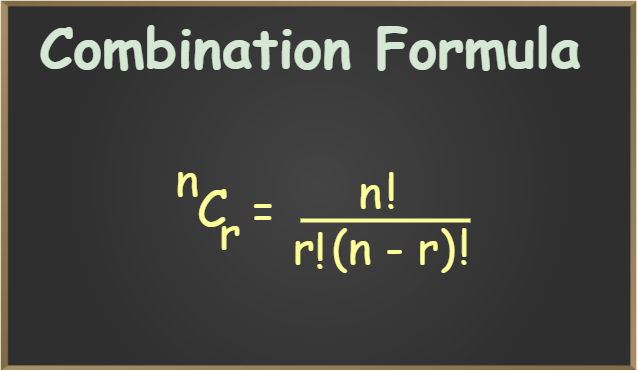Table of Contents
Permutation and Combination are the ways to write a group of objects by selecting them in a specific order and forming their subsets. To arrange groups of data in a specific order permutation and combination formulas are used. Selecting the data or objects from a certain group is said to be permutations, whereas the order in which they are arranged is called combination. Permutation and Combination formulas are very useful in solving various problems in mathematics.
Permutation
It is the distinct interpretations of a provided number of components carried one by one, or some, or all at a time. For example, if we have two components A and B, then there are two likely performances, AB and BA.
A numeral of permutations when ‘r’ components are positioned out of a total of ‘n’ components is n Pr = n! / (n – r)!. For example, let n = 3 (A, B, and C) and r = 2 (All permutations of size 2). The answer is 3!/(3 – 2)! = 6. The six permutations are AB, AC, BA, BC, CA, and CB.
Explanation of Permutation Formula
A permutation is a type of performance that indicates how to permute. If there are three different numerals 1, 2 and 3 and if someone is curious to permute the numerals taking 2 at a moment, it shows (1, 2), (1, 3), (2, 1), (2, 3), (3, 1), and (3, 2). That is it can be accomplished in 6 methods.
Here, (1, 2) and (2, 1) are distinct. Again, if these 3 numerals shall be put handling all at a time, then the interpretations will be (1, 2, 3), (1, 3, 2), (2, 1, 3), (2, 3, 1), (3, 1, 2) and (3, 2, 1) i.e. in 6 ways.
In general, n distinct things can be set taking r (r < n) at a time in n(n – 1)(n – 2)…(n – r + 1) ways. In fact, the first thing can be any of the n things. Now, after choosing the first thing, the second thing will be any of the remaining n – 1 things. Likewise, the third thing can be any of the remaining n – 2 things. Alike, the rth thing can be any of the remaining n – (r – 1) things.
Hence, the entire number of permutations of n distinct things carrying r at a time is n(n – 1)(n – 2)…[n – (r – 1)] which is written as n Pr. Or, in other words,
n Pr = n!/(n – r)!
Combination
It is the distinct sections of a shared number of components carried one by one, or some, or all at a time. For example, if there are two components A and B, then there is only one way to select two things, select both of them.
Number of combinations when ‘r’ components are chosen out of a total of ‘n’ components is, nCr = n! / [(r!) x (n – r)!]. For example, let n = 3 (A, B, and C) and r = 2 (All combinations of size 2). The answer is 3!/((3 – 2)! × 2!) = 3. The six combinations are AB, AC, and BC.
nCr = nC(n – r)
Note: In the same example, we have distinct points for permutation and combination. For, AB and BA are two distinct items but for selecting, AB and BA are the same.
Explanation of Combination Formula
Combination, on the further hand, is a type of pack. Again, out of those three numbers 1, 2, and 3 if sets are created with two numbers, then the combinations are (1, 2), (1, 3), and (2, 3).
Here, (1, 2) and (2, 1) are identical, unlike permutations where they are distinct. This is written as 3C2. In general, the number of combinations of n distinct things taken r at a time is,
n Cr = n! /[r! × (n – r)!] = nPr/r!
Formulas Permutation and Combination
Various formulas are used to solve permutation and combination problems few important of them are given below:
Permutation Formula
Permutation formula is used to pick r things out of n different things in a specific order and replacement is not allowed.

Combination Formula
Combination formula is used to pick r things out of n different things, where the order of picking is not important and replacement is not allowed.

Derivation of Permutation and Combination Formulas
Permutations Formula: Total number of permutations of a set of n objects if r objects are taken at a time P(n,r) = n!/(n-r)!, where [n>= r]
Combination Formula: Total number of combinations of a set of n objects if r objects are taken at a time C(n,r) = n!/[r !(n-r)!], where [n>= r]
Derivation of these formulas is discussed below in this article.
Derivation of Permutations Formula
Permutation is selecting r distinct objects from n objects without replacement and where the order of selection is important, by the fundamental theorem of counting, we know
P (n, r) = n . (n-1) . (n-2) . (n-3)…… (n-(r+1))
Multiplying and Dividing above by (n-r) (n-r-1) (n-r-2)……….. 3. 2. 1,
P (n, r) = [n.(n−1).(n−2)….(nr+1)[(n−r)(n−r−1)(n−r−2)…3.2.1]/[(n−r)(n−r−1)(n−r−2)…3.2.1]
P (n, r) = n!/(n−r)!
Thus, the formula for P (n, r) is derived.
Derivation of Combinations Formula
Combination is choosing r items out of n items when the order of selection is of no importance. Its formula is calculated as,
C(n,r) = Total Number of Permutations /Number of ways to arrange r different objects.
[Since by the fundamental theorem of counting, we know that number of ways to arrange r different objects in r ways = r!]
C(n,r) = P (n, r)/ r!
C(n,r) = n!/(n−r)!r!
Thus, the formula for P (n, r) is derived.
Difference Between Permutation and Combination
Various differences between the permutation and combination can be understood by the following points:
- Permutation formulas are used when the order of arrangement is important. Combination formulas are used when the number of possible groups is to be found, and the order of arrangements is not important.
- Permutation formulas are used when different kinds of things are to be sorted. Combination formulas are used when similar kinds of things are to be sorted.
- Permutation of two things out of three given things a, b, c is ab, ba, bc, cb, ac, ca, whereas the combination of two things from three given things a, b, c is ab, bc, ca. In permutation ab and ba are considered s different arrangements whereas in combination they are considered as similar arrangements.
- Different possible arrangement of things is found by n Pr = n!/(n – r)! while the different possible selection of things is found by n Cr = n! /{r! × (n – r)!}
- Generally, for a given set of n out of r values, the value of the permutation is always bigger than the value of the combination by a factor of (r!).
Solved Example on Permutation and Combination
Example 1: Find the number of permutations and combinations of n = 9 and r = 3.
Solution:
Given, n = 9, r = 3
Using the formula given above:
Permutation:
nPr = (n!) / (n – r)!
= (9!) / (9 – 3)!
= 9! / 6! = (9 × 8 × 7 × 6! )/ 6!
= 504
Combination:
nCr = n!/r!(n − r)!
= 9!/3!(9 − 3)!
= 9!/3!(6)!
= 9 × 8 × 7 × 6!/3!(6)!
= 84
Example 2: In how many ways a committee consisting of 4 men and 2 women, can be chosen from 6 men and 5 women?
Solution:
Choose 4 men out of 6 men = 6C4 ways = 15 ways
Choose 2 women out of 5 women = 5C2 ways = 10 ways
The committee can be chosen in 6C4 × 5C2 = 150 ways.
Example 3: How considerable words can be created by using 2 letters from the term“LOVE”?
Solution:
The term “LOVE” has 4 distinct letters.
Therefore, required number of words = 4P2 = 4! / (4 – 2)!
Required number of words = 4! / 2! = 24 / 2 = 12
Example 4: Out of 5 consonants and 3 vowels, how many words of 3 consonants and 2 vowels can be formed?
Solution:
Number of ways of choosing 3 consonants from 5.
= 5C3
Number of ways of choosing 2 vowels from 3.
= 3C2
Number of ways of choosing 3 consonants from 2 and 2 vowels from 3.
= 5C3 × 3C2
= 10 × 3
= 30
It means we can have 30 groups where each group contains a total of 5 letters (3 consonants and 2 vowels).
Number of ways of arranging 5 letters among themselves
= 5! = 5 × 4 × 3 × 2 × 1 = 120
Hence, the required number of ways
= 30 × 120
= 3600
Example 5: How many different combinations do you get if you have 5 items and choose 4?
Solution:
Insert the given numbers into the combinations equation and solve. “n” is the number of items that are in the set (5 in this example); “r” is the number of items you’re choosing (4 in this example):
C(n, r) = n! / r! (n – r)!
= 5! / 4! (5 – 4)!
= (5 × 4 × 3 × 2 × 1) / (4 × 3 × 2 × 1 × 1)
= 120/24
= 5
The solution is 5.
Example 6: Out of 6 consonants and 3 vowels, how many expressions of 2 consonants and 1 vowel can be created?
Solution:
Number of ways of selecting 2 consonants from 6.
= 6C2
Number of ways of selecting 1 vowels from 3.
= 3C1
Number of ways of selecting 3 consonants from 7 and 2 vowels from 4.
= 6C2 × 3C1
= 15 × 3
= 45
It means we can have 45 groups where each group contains a total of 3 letters (2 consonants and 1 vowels).
Number of ways of arranging 3 letters among themselves.
= 3! = 3 × 2 × 1
= 6
Hence, the required number of ways.
= 45 × 6
= 270
Example 7: In how many distinct forms can the letters of the term ‘PHONE’ be organized so that the vowels consistently come jointly?
Solution:
The word ‘PHONE’ has 5 letters. It has the vowels ‘O’,’ E’, in it and these 2 vowels should consistently come jointly. Thus these two vowels can be grouped and viewed as a single letter. That is, PHN(OE).
Therefore we can take total letters like 4 and all these letters are distinct.
Number of methods to organize these letters.
= 4! = 4 × 3 × 2 × 1
= 24
All the 2 vowels (OE) are distinct.
Number of ways to arrange these vowels among themselves.
= 2! = 2 × 1
= 2
Hence, the required number of ways.
= 24 × 2
= 48.
FAQs on Permutations and Combinations
Question 1: What is the factorial formula?
Answer:
Factorial formula is used for the calculation of permutations and combinations. The factorial formula for n! is given as
n! = 1 × 2 × 3 × 4 × …….× n
For example, 5! = 5 × 4 × 3 × 2 × 1 = 120.
Question 2: What does nCr represent?
Answer:
nCr represents the number of combinations that can be made from “n” objects taking “r” at a time.
Question 3: What do you mean by permutations and combinations?
Answer:
A permutation is an act of arranging things in a specific order. Combinations are the ways of selecting r objects from a group of n objects, where the order of the object chosen does not affect the total combination.
Question 4: Write examples of permutations and combinations.
Answer:
The number of 3-letter words that can be formed by using the letters of the word says, HELLO; 5P3 = 5!/(5-3)! this is an example of a permutation.
The number of combinations we can write the words using the vowels of the word HELLO; 5C2 =5!/[2! (5-2)!], this is an example of a combination.
Question 5: Write the formula for finding permutations and combinations.
Answer:
- Formula for calculating permutations: nPr = n!/(n-r)!
- Formula for calculating combinations: nCr = n!/[r! (n-r)!]
Question 6: Write some real-life examples of permutations and combinations.
Answer:
Sorting of people, numbers, letters, and colors are some examples of permutations.
Selecting the menu, clothes, and subjects, are examples of combinations.
Question 7: What is the value of 0!?
Answer:
The value of 0! = 1, is very useful in solving the permutation and combination problems.





